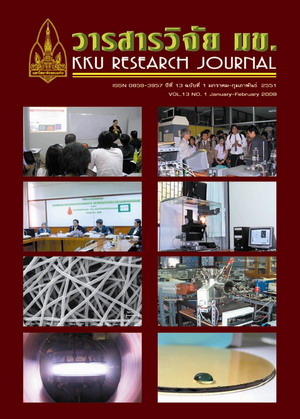Use of organic materials in methane mitigation organic- rice field (Thai)
Main Article Content
Abstract
Thailand is implementing to be a world center of safe food production. The demand for Thai organic-rice
is increasing in the foreign market. It is critically important to acquire environment-friendly technology for
organic-rice production. Paddy fields are well known as a source of greenhouse gasses, i.e. carbon dioxide
(CO2), methane (CH4) and nitrous oxide (N2O), contributing to global warming. A field experiment was
conducted on loamy soil. Various organic amendments and water managements encompassed with 6 treatmentswere designed, using factorial in RCBD with 3 replications. Stimulant LDD. 1 (Land Development Department) was applied to the whole experiment. The plot with incorporation of rice stubble residues (without external organic amendments) and kept in continuous flooding (F1) provided 908 kg/rai of rice; the methane emission per unit grain (MPG) 479 g CH4/kg grain, and methane emission reduced by 64.4% when compared to the plot with incorporation of rice stubble residues and 800 kg/rai of rice straw and kept in continuous flooding
(F2). Moreover, F1 gave high profit 4,331 baht/rai with 3.14 economic return. The maximum rice production
from the present experiment was 1,033 kg/rai obtained from the plot with incorporation of 600 kg/rai rice
stubble residues, 400 kg/rai rice straw and 1,600 kg/rai burn rice husk (F4); this treatment emitted 841 g
CH4/kg grain and reduced CH4 by 29% when compared to F2. However, F4 gave 3,191 baht/rai with 1.79
economic return. Results revealed that total methane emission (TME) and methane emission per unit grain
(MPG) of the present experiments were 22 and 10 times higher than those from previous experiments with
chemical fertilizers. As a conclusion, emphasis on the management of organic materials and water is critically
important for organic rice production
is increasing in the foreign market. It is critically important to acquire environment-friendly technology for
organic-rice production. Paddy fields are well known as a source of greenhouse gasses, i.e. carbon dioxide
(CO2), methane (CH4) and nitrous oxide (N2O), contributing to global warming. A field experiment was
conducted on loamy soil. Various organic amendments and water managements encompassed with 6 treatmentswere designed, using factorial in RCBD with 3 replications. Stimulant LDD. 1 (Land Development Department) was applied to the whole experiment. The plot with incorporation of rice stubble residues (without external organic amendments) and kept in continuous flooding (F1) provided 908 kg/rai of rice; the methane emission per unit grain (MPG) 479 g CH4/kg grain, and methane emission reduced by 64.4% when compared to the plot with incorporation of rice stubble residues and 800 kg/rai of rice straw and kept in continuous flooding
(F2). Moreover, F1 gave high profit 4,331 baht/rai with 3.14 economic return. The maximum rice production
from the present experiment was 1,033 kg/rai obtained from the plot with incorporation of 600 kg/rai rice
stubble residues, 400 kg/rai rice straw and 1,600 kg/rai burn rice husk (F4); this treatment emitted 841 g
CH4/kg grain and reduced CH4 by 29% when compared to F2. However, F4 gave 3,191 baht/rai with 1.79
economic return. Results revealed that total methane emission (TME) and methane emission per unit grain
(MPG) of the present experiments were 22 and 10 times higher than those from previous experiments with
chemical fertilizers. As a conclusion, emphasis on the management of organic materials and water is critically
important for organic rice production
Article Details
How to Cite
Saenjan, P., Prongjuntek, K., & Tulaphittak, D. (2017). Use of organic materials in methane mitigation organic- rice field (Thai). Asia-Pacific Journal of Science and Technology, 13(1), 114–125. retrieved from https://so01.tci-thaijo.org/index.php/APST/article/view/83745
Section
Research Articles
References
-


